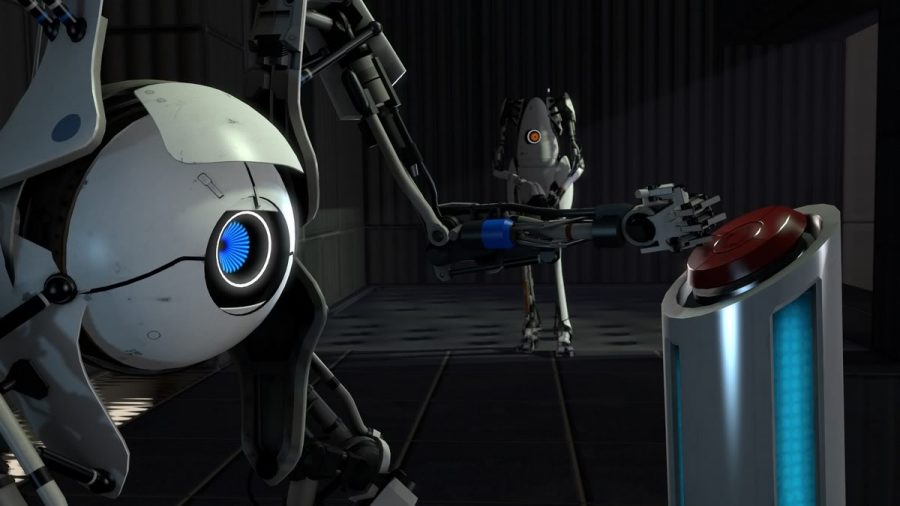
Post-apocalyptic stories are quite common in entertainment media these days. In this regard, the video game “Portal 2,” set in the fictional, isolated Aperture Science laboratories long after a hinted-at collapse of society, could be called unoriginal. But this overlap with pop-culture cliché is slight, and it’s one of the only ones present in the game. In every other way, “Portal 2” is a singular and unique game, alike only to its predecessor and rivaled by none.
“Portal 2” looks and feels like a first-person shooter, but it isn’t really. It is instead a puzzle game. “Portal 2,” akin to its prequel, is a game of brains and skills over weapons or strength. The player must use his or her cleverness rather than dumb firepower to solve the puzzles presented. This kind of intellectually focused game play is refreshing, stimulating, and in ways more engaging than the brand of mindless action so commonly found in contemporary shooter games like “Call of Duty: Black Ops” and other popular titles.
The central idea of “Portal 2”, as can be derived from its title, is the use of inter-dimensional portals. The player is armed with a “Handheld Portal Device,” which can fire two different portals, one orange, and one blue, at wall surfaces. When both portals are active, objects (such as the player) that enter one portal will come out the other one, wherever it may be. The player must use logic skills to navigate test chambers and other areas of the labyrinthine Aperture Science complex and progress in the game. Other factors, such as lasers, weighted cubes, springboards, light-bridges and overexcited gunner robots sometimes complicate the puzzles.
But the game isn’t merely about test chambers. “Portal 2” has a plot, which exists beyond those rigid, clean-cut puzzles. The first “Portal” was played as a lone test subject, for all intents and purposes the only human in the Aperture labs – and as such, the only test subject to be played with by the deranged AI system in charge, GLaDOS. The game ended with the protagonist defeating GLaDOS, and being thrown to the surface by the resulting explosion, unconscious. The second game starts with this same test subject. Again a captive of the Aperture laboratories, the protagonist’s goal is to escape back to the surface again, this time for good. On this escape route, the player also traverses the gritty belly of the laboratories in depth, often by using the same logic that they learned in test chambers. A similar plot trend as was also pursued in “Portal” the first time.
However “Portal 2” doesn’t just feel like a continuation of the first game. Instead, it feels like an all-out expansion of it. The universe of the original “Portal” was murky, undefined, and mysterious; many of these mysteries are delved into in the second installment in the series. “Portal 2” has more nuance, more plot complexity, than its predecessor and is probably aided by the fact that it is significantly longer than the original, which was both praised and decried for its infamous brevity.
“Portal 2” is only distinguishable from “Portal” in a few ways: it has slightly better graphics, newly introduced testing elements, fresh test chambers and a new story, to name a few variations. But undoubtedly the most significant difference between “Portal” and “Portal 2” is the presence of a separate, two-person cooperative play story line in “Portal 2,” the likes of which did not exist in the first game.
Yet the Co-op game experience is what makes “Portal 2” really stand out as something different and superior to the original. With individual play, all puzzles are yours alone to figure out. But with two players, the brain burden is shared. As such, the complexity and difficulty of puzzles can and does increase in a rather delicious manner. The two-player story line is that of two Aperture Science robots who are being used as test subjects. Teamwork, joint intellect, and expert timing are necessary to pass through the co-op tests. The cut scene videos of the robot pair, too, are downright funny in a simple, slapstick way. The easy laughs provide good balance in “Portal 2,” especially when compared to the darker single-player story line.
In the end, “Portal 2” eclipses the individuality of its predecessor. “Portal 2” overlaps with “Portal” enough to connect the two games, but at the same time, “Portal 2” can stand by itself.
Written by Aaron Newman. This article originally appeared in the June 2011 issue.


